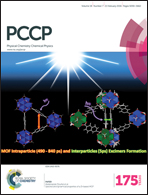Transferability of different classical force fields for right and left handed α-helices constructed from enantiomeric amino acids†
Abstract
Amino acids can form D and L enantiomers, of which the L enantiomer is abundant in nature. The naturally occurring L enantiomer has a greater preference for a right handed helical conformation, and the D enantiomer for a left handed helical conformation. The other conformations, that is, left handed helical conformations of the L enantiomers and right handed helical conformations of the D enantiomers, are not common. The energetic differences between left and right handed alpha helical peptide chains constructed from enantiomeric amino acids are investigated using quantum chemical calculations (using the M06/6-311g(d,p) level of theory). Further, the performances of commonly used biomolecular force fields (OPLS/AA, CHARMM27/CMAP and AMBER) to represent the different helical conformations (left and right handed) constructed from enantiomeric (D and L) amino acids are evaluated. 5- and 10-mer chains from D and L enantiomers of alanine, leucine, lysine, and glutamic acid, in right and left handed helical conformations, are considered in the study. Thus, in total, 32 α-helical polypeptides (4 amino acids × 4 conformations of 5-mer and 10-mer) are studied. Conclusions, with regards to the performance of the force fields, are derived keeping the quantum optimized geometry as the benchmark, and on the basis of phi and psi angle calculations, hydrogen bond analysis, and different long range helical order parameters.


 Please wait while we load your content...
Please wait while we load your content...